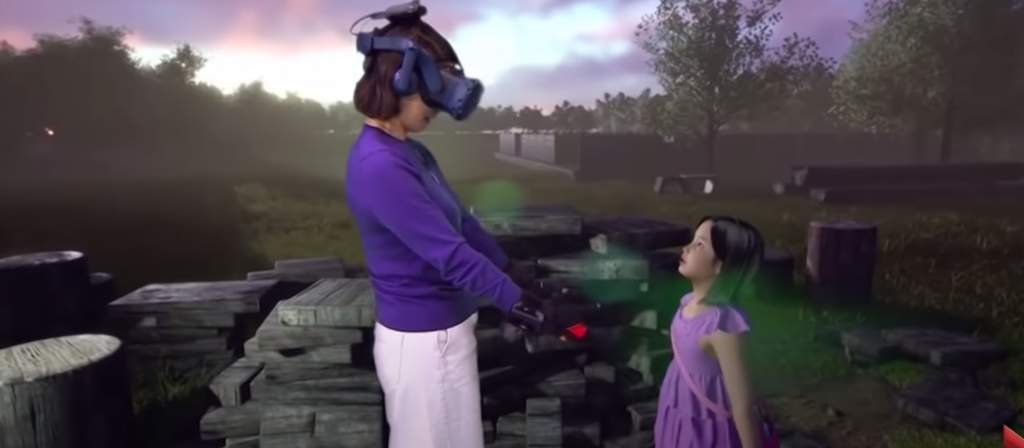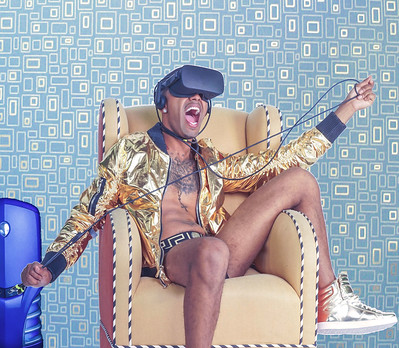In February we saw clips of a Korean TV show in which a mother was reunited in virtual reality with her young daughter who had passed away. It made for emotional viewing, perhaps overwhelmingly so.
The footage showed how VR can now provide experiences that speak to the deepest parts of the human condition. It also opened the eyes of many who previously saw the technology as just a benign form of entertainment. Confronted with the intensity of human grief, suddenly this technology appears to be opening up new emotional experiences that weren’t previously available to us. This is prompting many to consider both the exciting possibilities on the horizon, but also the ethical boundaries of virtual reality technology.
At the moment there seem to be three areas of most concern. To begin with, we have the desire to replace our relatively mundane (or painful) realities with something more exciting and malleable (VR Escapism). Once the technology is suitably advanced, there will be many who wish to spend the majority of their time in a virtual world in order to escape the reality they otherwise live in.
The second area of concern is the ever-present ethical ambiguity of bringing fantasy to life (VR Fantasy). VR can offer people grand adventures, new identities and fantastic landscapes; but it can also generate experiences that emerge from the darker areas of the human mind that might otherwise be unattainable, often for legal and moral reasons.
The third area, which has most recently come into public consciousness, is that of human grief and loss (VR Grief). There are clearly many areas in which virtual reality technology can be used effectively in a therapeutic setting. The question, at some point, becomes whether or not we risk losing an important part of ourselves by creating simulacrums that are digital fragments of a faded past.
These categories, for widely different reasons, will be driving forces in bringing virtual reality to the mainstream. The majority of uses will be inspiring, positive and/or entertaining.
But where do the ethical boundaries of virtual reality lie?
VR Escapism
2020 has certainly been a year that many people would rather replace with a more uplifting version. Will VR ever reach the point that users would prefer to stay within a virtual environment than live in the real world? How many of us will be enamoured by the technology to the point of detriment to our health, work and connection with family or friends? Could VR end up detaching us from reality as much as enhancing it?
If you believe in simulation theory, then maybe we’re already detached from base reality. However, VR Escapism is less about an overarching simulation that we’re not aware of and more a conscious choice to turn away from the material world in preference for a virtual one that can be tailored to personal preferences and desires.
One of the more widely discussed areas of concern when it comes to virtual reality, VR Escapism presents the kind of future often depicted in science fiction; with broad overtones of addiction to escape poverty and extreme inequality. It’s also an image that will cause anxiety to parents around the world, as they watch their kids with an opaque headset enjoying the technology more and more as it advances.
In many ways, the concern here is an extension of those already raised by our smartphone use and the addictive qualities of social media. Human beings are social animals; biologically incentivised to seek out positive social cues and the acceptance of our peers. Social media has proven to be addictive in nature because of its ability to circumvent the usual restrictions of time and place that our social interactions normally require. Instead of waiting to catch up with friends in person, we can now interact with them at any time. This is combined with the ability to reach outside of our peer groups and into an infinite world of social interactions with strangers all over the world.
When it comes to smartphones, we are able to engage in the feedback loop of digital social engagement when going about the rest of our lives. The amount that we use our phones might negatively impact other things we are doing at the time (such as spending time with family) but at least there is a possibility for parallel engagement. Virtual reality removes that possibility, by requiring us to shut out the material world in favour of the digital environments on offer.
There will also be a wide range of accessories (including sexual ones) and other products (such as food alternatives) that can maximise time spent in virtual reality, removing the need to leave virtual worlds in order to eat, sleep, socialise, work or even take care of hygiene.
We will need to find ways to overcome circumstances where individuals have lost the ability to discern the negative impact VR might be having on their lives. Things such as VR addiction counselling; parental time locks and content oversight; and medical studies on the impact of long-term VR usage will be needed as the technology becomes more mainstream. Effective forms of education will also be required to help ensure that individuals can make informed judgments. Ironically, much of this education could even take place within virtual reality itself; alongside ways for users to accurately track and self-limit usage according to their own thresholds and needs.
VR Escapism, however, isn’t just about individuals losing themselves in virtual worlds by choice. It’s also about considering to what extent we will allow those who profit from our usage — whether agents of commercial or political interests — to construct experiences engineered to encourage excessive use and addiction.
A good example of the positive use of VR has been in the rehabilitation of prisoners, but there is also the more distant possibility of creating VR prison environments. Possibly to the extent where the ‘inmate’ might not even realise that they are being held there at all. With the advent of neural implants, it’s not too much of a stretch to consider a time when we might not have full control of the reality that we experience. It seems likely that such technology would first be used on those we consider irredeemable in society.
VR could also be used as a form of torture or interrogation; with hellish landscapes created to scar the mind, or convincing environments used to get people to open up their secrets. All of these uses will become possible and therefore increasingly likely to occur at some point. Once we have put our trust into whichever institutions control technology that has merged with our own brains and construction of consciousness, then we have handed over the keys to our experience of reality. As we have seen with government surveillance of citizens and corporate harvesting of our personal data, this trust will be misplaced if we think it will be used to act only in our own collective interests and not those seeking to uphold the power structures they benefit most from.
In the more dystopian projections seen in science fiction, our lives and homes become empty shells that provide little more than the equipment needed to escape into virtual worlds; freed from the limitations of our day-to-day existence. The thought of how liberating and enjoyable VR could become is intoxicating; but where does the boundary lie in which putting aside our physical surroundings becomes problematic for the social interactions and material engagement that makes up a large part of our wellbeing?
![Untitled [Coty] (c.1917) - Amadeu de Souza-Cardoso (1897-1918)](https://www.futureconscience.com/wp-content/uploads/2020/05/VR-2020-Pedro-Simoes-e1590959902927.jpg)
VR Fantasy
Closely related to VR Escapism, and often overlapping, is the world of VR Fantasy. This is slightly different to escapism, in that it relies entirely on creating situations that normally aren’t possible to engage in outside of virtual reality. This is where the bulk of VR entertainment will exist, such as videogames and other immersive experiences, but it’s also where some of the seedier and more violent elements will emerge.
Ethical boundaries quickly come into play when real-life counterparts are used. Consider how problematic the first VR version of a school-shooting simulator will be. Combine that with room-mapping technology that is becoming more available, and the experience could even be tailored to a specific building or workplace. Deepfake technology could populate the simulation with the faces of real people. Suddenly the violence that ensues looks less like the standard first-person shooter and more like a terrorist training simulator.
When it comes to the content of virtual reality software, boundaries will be found (and overstepped) through the relationship between legal restrictions and moral considerations. Like with any other medium, though, this will not entirely restrict the kinds of content available that might be highly detrimental or abusive.
The question of legal responsibility will be difficult to tackle, particularly with the growing trend that allows users themselves to create content. This has been the case recently with controversies surrounding deep fake pornography, which have flourished even under the threat of criminal charges and expensive lawsuits. Other forms of extremely violent and illegal behaviour, such as sexual assault, child abuse and hate crime, all have examples in digital software [no, I’m not linking them] even though they are obviously wrong or at the very least highly questionable from a moral standpoint. The lines between legitimate art that provokes and questions; entertainment that explores heavy or hurtful themes; and other more debased forms of virtual media which unnecessarily feed the darker side of humanity is something that legal restrictions can’t address with any real clarity.
But perhaps it’s not enough to just say that disturbing content will be available and individuals need to self-monitor and steer clear of anything too questionable. Virtual reality provides an immersive and emotionally resonant experience more akin to reality than reading fiction, viewing art or watching depictions shown in films. We therefore need to think carefully about where the boundaries of moral behaviour and legal restrictions might lie and more research must be done in how human psychology delineates between physical and virtual worlds. Having said this, we also need to avoid unnecessary witch-hunts that tear down a new medium before it can properly develop the complexity of traditional art forms such as literature and cinema.
One thing we can be sure of is that material that is controversial already exists and will only become more prevalent. The kinds of (unfounded) outrage seen in the early days of videogames have some more justifiable examples when it comes to virtual reality. The experiences are visceral, fully immersive and create memories more similar to physical experiences than gaming through a flatscreen monitor.
They will also be assisted by additional technology that engages the senses and brings examples of extremely damaging behaviour right up to the line of physical reality. How far is the step from such a virtual experience into the obsessive desire for a real one? It’s an ethical boundary of VR Fantasy that needs to be carefully considered and not just waved away.

VR Grief
Therapeutic techniques are already finding a footing in virtual reality with some clearly beneficial examples. Research into the impact of VR therapy on issues such as dementia, social anxiety, phobia treatment and other mental health areas shows that the immersive medium is an effective tool in helping people overcome deep personal challenges. When it comes to overcoming grief, however, the response is much more controversial.
Many people can see huge benefit in allowing people to find a space to visit their emotions of loss, particularly in such a controlled environment. At its most basic level, VR can simply emulate a group therapy setting and allow people from different locations to connect with others going through similar experiences.
However, there are others who feel that by extending these difficult parts of the human experience into virtual reality we are somehow short-circuiting part of the natural grieving process. Doing so could have unintended consequences and maybe even stunt the ability for people to move on. Maybe this is a case of our technology moving more quickly than other areas of our evolution (both physical and emotional) might be able to handle.
It’s a difficult area to think about from an ethical perspective, primarily because it is so case dependent. We all have photos and (if we’re lucky) videos of loved ones that are no longer here. These things provide solace and help maintain the memory of those closest to us. Virtual reality, when done properly and respectfully, could be viewed as an amalgamation of all of these elements already rely upon when it comes to living with grief. It will allow a more immersive environment for us to combine them into a single, powerful experience. Reliving these memories will become (indeed, have already become with 360-degree video) a possible component of how we remember those most important to us when they are gone.
The concern might stem, therefore, from the kind of uncanny valley problem we have with human simulacra in general. This issue is one thing when talking about a video game or interactive movie; but it’s an entirely different one when the simulation is of someone we knew deeply. In these cases, the connection goes well beyond the external markers of visual appearance and speech. It will be near impossible, at least in the foreseeable future, for simulations of lost loved ones to capture the essence of being that made them unique. Instead, we will be left with something evoking powerful emotions of reunification, but quickly met with an underlying hollowness that becomes more unsettling the longer we spend with such echoes of the past.
There is also the issue of ‘grief tourism’ that emerges from immersive experiences of traumatic events. The VR experience [08:46], that allows people to relive the 9/11 terrorist attacks, was hugely controversial and widely condemned as exploitative. Others felt that it allowed an enhanced degree of empathy and that understanding how tragic these events were, beyond just viewing them through the emotional detachment of a television or textbook, was an important educational tool.
It’s for these more educational and historical reasons that the concerns about somehow moving too quickly for our humanity to adapt might be overstated. VR experiences will allow us to better understand the tragic events that others have gone through around the world and hopefully therefore allow us to adapt more successfully to the hyperactive pace of modern global life.
When it comes to individual experiences of loved ones, they will be missing the vital components that make up the soul of the person that we have lost. Maybe this will allow us to not get lost in them, but rather see them as extensions of photos and videos that allow us an immersive moment of remembrance. For others, though, it will make moving on a much more difficult task.
VR Grief is an area where the ethical boundaries will be much more specific to individual understandings of life, death and personal beliefs. For some they will be avoided at all costs, for others they will provide exactly the right kind of solace needed to get through difficult times. They might even make society as a whole a bit more compassionate.

Conclusion
Even though we can see areas of concern already emerging, the three categories above also have huge potential benefits to them. That much is self-evident, but it’s important that we can discuss some of the ethical boundaries that virtual reality might cross without fear of somehow sabotaging the technology. Issues of addiction; criminal behaviour; privacy and consent in shared environments are boundaries that will map more directly and we can already begin to overcome them through how virtual reality is designed and formulated.
There are also more mundane economic questions raised, such as whether it might impact the tourism industry and therefore the economic needs of many small communities around the world. When all things can be experienced virtually, will the industries that supply us with real-world experiences find it difficult to continue operating in the same way?
There will also be issues that we can’t foresee until the technology is widely used. Like all technology, virtual reality is an extension of what we already are; but it is also one that alters the foundation of our experience of reality in ways that make the long-term impact of overstepping any ethical boundaries difficult to gauge.
We are approaching a time in which our relationship with material reality will be inalterably changed and new modes of human existence will spring forth. A new era of creativity, self-exploration and shared entertainment will emerge. Improvements to areas of therapy and education will be gifts worth taking advantage of. However, this paradigm shift will also start to undermine and erode a deep-seated relationship with the material world that we have held for millennia and goes far back into our pre-human ancestral past.
What impact this has on the core of our being and how we construct personal identity, social relationships and public institutions is difficult (if not impossible) to predict. Let’s hope that a good sense of our ethical boundaries might remain to help us steer VR through to a bright and beneficial future.







